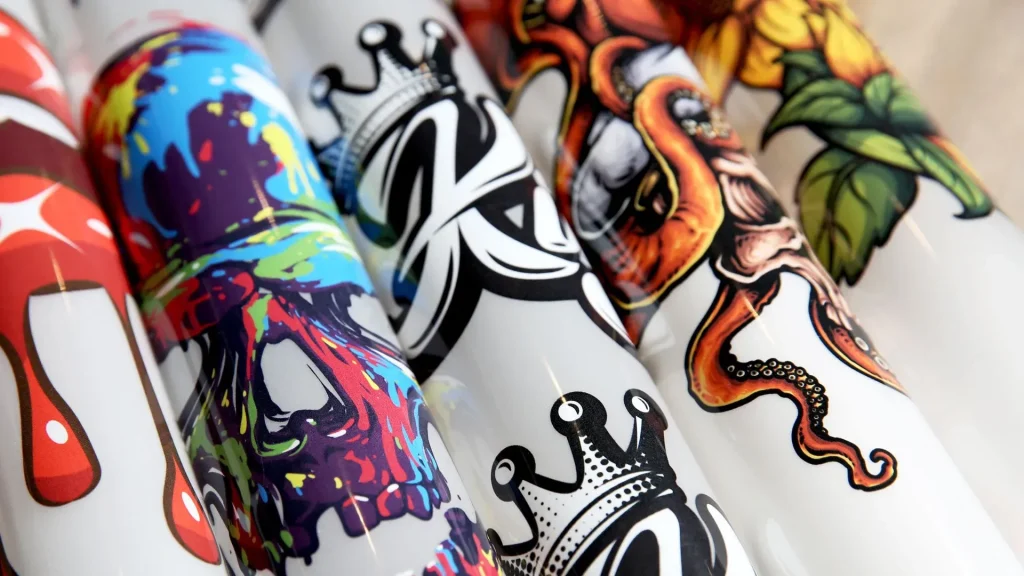DTF transfers, or Direct-to-Film transfers, have become a revolutionary method in custom apparel printing, catching the attention of both seasoned professionals and enthusiastic beginners. This innovative technique not only produces vivid and eye-catching designs but also offers exceptional durability that withstands the test of time and wear. Whether you’re eager to learn how to do DTF transfers or searching for the best DTF printers, this guide is here to assist you in navigating the intricate DTF printing process. By mastering effective DTF transfer tips and techniques, you’ll elevate your crafting skills and create stunning results that can impress even the most discerning customers. Dive in as we explore the essential methods and insights that will help you unlock the full potential of DTF printing techniques and elevate your textile art.
Direct-to-Film printing, often abbreviated as DTF, has emerged as a powerful alternative in the realm of garment decorating, leading to a surge in popularity for its efficiency and vibrant output. This method involves applying images onto a film that can be effortlessly transferred onto various fabrics, resulting in high-quality, durable designs. For those curious about the nuances involved in this printing style, exploring related practices such as heat transfer vinyl (HTV) and sublimation printing can also provide a broader understanding of customization options available in apparel. As you familiarize yourself with DTF transfer methods, you’ll discover valuable insights that can elevate your creative projects and inform you of the best practices to achieve vivid imagery and exceptional results. Join us on a deep dive into the tools, techniques, and tips necessary to fully embrace the art of DTF and make your fabric designs truly stand out.
Essential Techniques for High-Quality DTF Transfers
To excel in DTF transfers, mastering essential printing techniques is a must. Begin with ensuring the design you plan to print is optimized for DTF technology. This means using software that allows for high-resolution outputs, suitable color profiles, and appropriate file types. Furthermore, it’s important to set your printer settings to match the specific film and ink you are using. For example, adjusting the print speed and ink density can significantly impact the quality of the transfer and its adherence to the substrate.
Another vital technique is understanding the transfer application process. Properly aligning your film and fabric is critical before applying heat. Make sure to practice with scrap materials to get the hang of the timing and temperature settings required to achieve durable transfers. It’s also advisable to conduct initial tests with different pressures and times to find the sweet spot that yields the best results. Remember, the consistency you achieve in these preliminary steps can define the quality of your final products.
Choosing High-Quality Equipment for DTF Printing
Selecting the right equipment is fundamental to successful DTF transfers. Investing in high-quality DTF printers ensures that you achieve the best possible results. Brands such as Epson and Roland are renowned for their performance and reliability in this space. Not only can these printers produce vivid colors and fine details, but they also offer the ability to print on various media types, which is essential for versatility in custom product offerings.
In addition to the printer, choosing an efficient heat press is crucial. Look for models that allow precise control over temperature and pressure, as this can greatly affect the transfer quality. A press that evenly distributes heat will help you avoid issues such as incomplete transfers or peeling. Consider your production volume and workflow as well, ensuring that your setup meets your business needs while also enabling high-quality outputs.
Understanding the Role of Film and Ink in DTF Transfers
The choice of film and inks used in the DTF process cannot be understated, as they play a significant role in the durability and appearance of the final product. DTF films are available in various finishes, such as glossy or matte, which can alter the overall look of your design. Selecting the right film for your fabric type is essential for optimal adhesion and vibrant results, making thorough research worthwhile before making a purchase.
Likewise, the quality and formulation of your inks will influence the transfer process. Opting for specially formulated inks for DTF applications is critical. These inks bond effectively with both the film and the fabric, which not only enhances the vibrancy of colors but also ensures that the prints withstand washing and wear. Experimenting with different combinations of films and inks can provide insights into the best options for your unique projects.
Best Practices for Pre-treatment and Post-treatment in DTF Transfers
Pre-treatment is a crucial step in the DTF transfer process that ensures the longevity and quality of the prints. Applying adhesive powder to the fabric before the transfer not only helps the ink to bond effectively with the fibers but also enhances the print’s washability. It’s essential to apply the powder evenly, and this can typically be done with a simple spray application. Investing adequate time in mastering this step can yield significantly more durable and stunning results.
After the transfer process, post-treatment steps are just as important. Curing the print through heat applications not only sets the ink but also enhances the overall quality and vibrancy of the design. Failure to do so can result in prints that fade or peel after washing. Always follow the recommended curing times and temperatures for the best results. Additionally, leveraging tools like heat guns or specialized curing machines can streamline this process, ensuring that your prints are ready for long-term use.
Color Management Techniques for Stunning DTF Prints
Effective color management is fundamental to achieving stunning consistency in your DTF prints. Utilizing color profiles that are specifically tailored for your printer and ink combination is essential. Without these profiles, you risk color inaccuracies that can detract from the intended design. Ensuring that you have calibrated your printer regularly can also make a significant difference; this involves adjusting settings to maintain accurate color reproduction throughout your projects.
Conducting test prints is another strategy that can aid in fine-tuning your colors. By printing smaller samples before committing to full-sized outputs, you can evaluate and adjust colors as needed, reducing waste and saving materials. Incorporating software that allows for color correction can also provide an edge. The ability to make minor tweaks before the final prints will help ensure that the colors match your original intentions, leading to delightful results in your DTF transfers.
Common Troubleshooting Tips for DTF Printing Issues
As with any printing techniques, challenges can arise during the DTF transfer process. Common issues such as ink smudging, improper adhesion, or inconsistent prints can be discouraging, but many can be avoided with attentive practices. Regular maintenance of your equipment, particularly cleaning the print heads, is essential to ensure consistent ink flow and prevent clogs that can derail your prints.
Additionally, understanding the parameters of your heat press can help troubleshoot issues related to temperature and pressure. Keeping a log of settings for different films and fabrics can guide you in adjusting these parameters quickly if problems arise. Don’t forget to leverage online resources such as forums and tutorials, as they can broaden your understanding and provide insights from other professionals who have navigated similar challenges.
Frequently Asked Questions
What is the process of DTF transfers and how does it work?
DTF transfers, or Direct-to-Film transfers, involve printing designs onto a specialized film, which is then transferred to fabric using heat and pressure. This process allows for vibrant, durable designs that adhere well to various substrates, ensuring the prints last through numerous washes.
What are the best DTF printers for high-quality results?
The best DTF printers currently recommended include those from brands like Epson and Roland. These printers are known for their reliability and ability to produce high-resolution images that showcase brilliant colors, making them ideal for DTF printing techniques.
How do I ensure successful adhesion in DTF printing?
Successful adhesion in DTF printing can be achieved by properly pre-treating your fabric with specialized adhesive powder before the transfer process. This step is crucial as it allows the ink to bond effectively to the fabric fibers, enhancing the durability of your DTF transfers.
What are some essential DTF transfer tips for beginners?
For beginners mastering DTF transfers, it’s important to invest in quality equipment and inks, understand the pre-treatment and post-treatment processes, and regularly maintain your printer. Online tutorials and community forums can also provide valuable insights and troubleshooting help.
How can I manage colors efficiently in my DTF printing process?
Efficient color management in DTF printing involves utilizing specific color profiles for your printer and inks. Conducting regular calibrations and running test prints will help achieve accurate color fidelity, ensuring that your DTF transfers closely match your design expectations.
What common issues might I face with DTF transfers and how can I troubleshoot them?
Common issues with DTF transfers include ink smudging, poor adhesion, and blotchy prints. These can often be resolved through regular print head maintenance, adjusting temperatures and pressure settings, and consulting tutorials for troubleshooting tips. Keeping your equipment in top shape is essential for consistent results.
| Key Aspect | Details |
|---|---|
| DTF Printing Process | Involves printing on film, then transferring to fabric with heat and pressure for durability. |
| Equipment Needed | Recommended brands include Epson and Roland for printers; heat press for precise application is essential. |
| Film and Ink | Various DTF films (matte and glossy) and specific inks for bonding and finish. |
| Pre-treatment Techniques | Applying adhesive powder for better ink adhesion is crucial. |
| Post-treatment Techniques | Curing fabric with heat enhances durability and vibrancy. |
| Color Management | Utilize color profiles and conduct regular calibrations for consistent colors. |
| Troubleshooting | Issues can include smudging or poor adhesion; maintenance and correct settings can help. |
Summary
DTF transfers are an innovative printing method that has revolutionized custom apparel design. This technique not only produces vibrant, high-quality prints but also showcases remarkable durability when applied correctly. By mastering the DTF process, from selecting the right equipment and materials to implementing effective pre-treatment and post-treatment techniques, you can create stunning apparel that stands the test of time. Engaging in color management and troubleshooting common issues will further refine your skills and enhance your results. As you embark on your journey with DTF transfers, embrace the creative possibilities that await!



